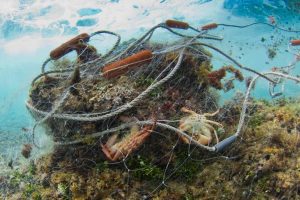
©FAO
El 2% de los ejercicios de la pesca y los utensilios utilizados provocan una gran contaminación en los océanos que afecta a alrededor de 700 especies marinas, gran parte de ellas en peligro de extinción.
Cada año se pierden en el mar 740.000 km de sedal y 14.000 millones de anzuelos. Estos materiales se conocen como Aparejos de Pesca Abandonados, Perdidos o Descartados -ALDFG, por sus siglas en inglés-.
Un equipo de científicos de la Universidad de Tasmania ha realizado un conjunto de entrevistas a 450 pescadores de siete de los mayores países pesqueros del mundo para conocer el impacto global de este tipo de contaminación. Estos resultados se dieron a conocer en un artículo llamado “Global estimates of fishing gear lost to the ocean each year”, publicado en la revista Science Advances.
Uno de los resultados obtenidos de este proyecto de investigación apunta a que, en los próximos 65 años habrá suficientes redes de pesca en el mar como para cubrir todo un planeta. Cabe tener en cuenta, también que las redes abandonadas -conocidas como artes fantasma-, pueden seguir pescando durante décadas, causando la captura y muerte accidental de muchos animales.
En cuanto a los datos, los autores estimaron que casi el 2% de todas las artes de pesca, los cuales comprenden 2.963 km2 de redes de enmalle, 75.049 km2 de redes de cerco, 218 km2 de redes de arrastre, 739.583 km de líneas principales de palangre y 25 millones de nasas y trampas, se pierden anualmente en los océanos. Esta recopilación de datos se ha hecho posible con la ayuda de los pescadores que han participado en el proyecto, quienes informan de lo ocurrido y muestran una gran preocupación por los hechos.
Las estimaciones de la investigación sólo incluyen datos de pesca comercial, sin tener en cuenta otros equipos perdidos de pescadores recreativos. Además, también se estimó que entre el 1.7% y el 4.6% de los residuos plásticos que se generan en tierra acaban en el mar, sabiendo que una gran cantidad proviene de estas artes de pescas perdidas.
Este fenómeno provoca grandes impactos al medio ambiente porque es la contaminación plástica más dañina para el entorno marino ya que, además de alterar la estabilidad del medio, provoca daños a la fauna al estar pensados para capturar animales.
__
ABANDONED, LOST OR DISCORDED FISHING GEAR
The 2% of fishing practices and the tools used cause a great deal of pollution in the oceans, affecting some 700 marine species, many of which are endangered.
Every year, 740,000 km of fishing line and 14 billion hooks are lost at sea. These materials are known as Abandoned, Lost or Discarded Fishing Gear (ALDFG).
A team of scientists from the University of Tasmania has conducted a series of interviews with 450 fishermen from seven of the world’s largest fishing nations to understand the global impact of this type of pollution. These results were reported in an article entitled “Global estimates of fishing gear lost to the ocean each year”, published in the journal Science Advances.
One of the results obtained from this research project points out that in the next 65 years there will be enough fishing nets in the sea to cover an entire planet. It should also be taken into account that abandoned nets, known as ghost gear, can continue fishing for decades, causing the capture and accidental death of many animals.
In terms of data, the authors estimated that almost 2% of all fishing gear, comprising 2,963 km2 of gillnets, 75,049 km2 of purse seines, 218 km2 of trawls, 739,583 km of longline mainlines and 25 million pots and traps, are lost annually in the oceans. This data collection has been made possible with the help of the fishermen who have participated in the project, who report what has happened and show great concern about the facts.
The research estimates only include commercial fishing data, without taking into account other lost equipment of recreational fishermen. In addition, it was also estimated that between 1.7% and 4.6% of the plastic waste generated on land ends up in the sea, knowing that a large amount comes from these lost fishing gears.
This phenomenon causes great impacts to the environment because it is the most harmful plastic pollution for the marine environment since, in addition to altering the stability of the environment, it causes damage to the fauna as it is designed to capture animals.
__

